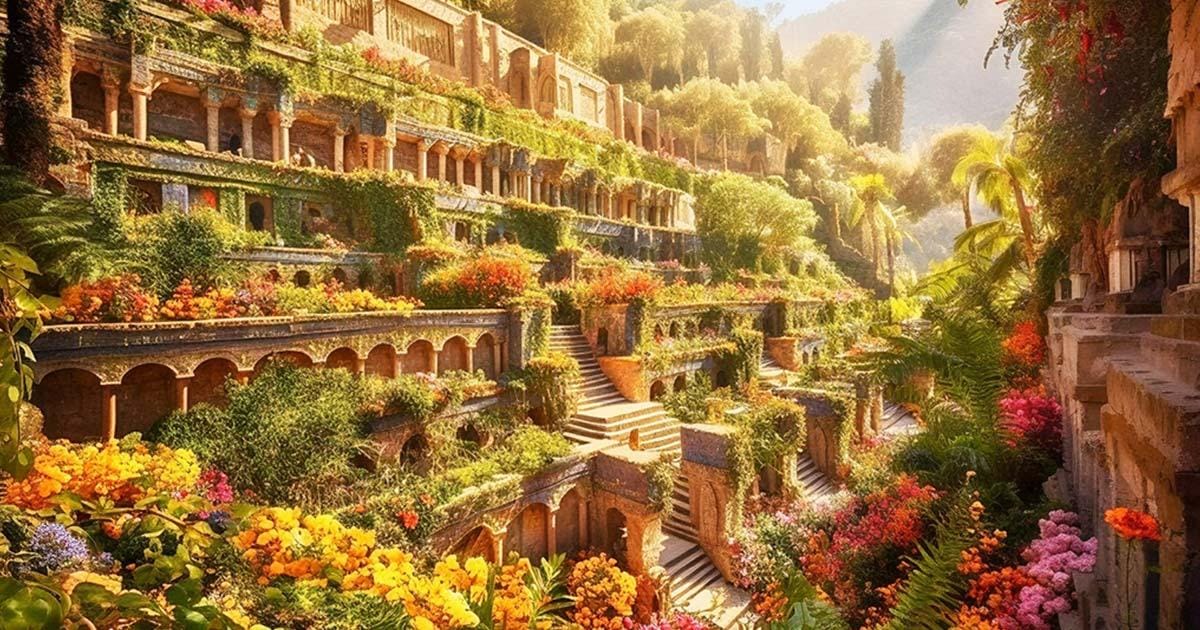Get ready for a wild ride through history as we explore the Hanging Gardens of Babylon, one of the most legendary wonders of the ancient world. We’ll dig deep into its secrets, unraveling how it was built, why it was so special, and what happened to this mind-boggling garden that left everyone in awe. Grab your shovel and let’s uncover the fascinating facts about this architectural marvel that made it one of the most buzzed-about places back in the day.
Interesting Facts About the Hanging Gardens of Babylon
The Hanging Gardens of Babylon have captivated our imaginations for centuries. These legendary gardens are a blend of history, mystery, and architectural wonder. Let’s delve into some fascinating facts about this ancient marvel:
1. Did They Even Exist? The Mystery Remains
Here’s the thing – we don’t have concrete archaeological evidence that the Hanging Gardens actually existed. This makes them the most mysterious of all the Seven Wonders of the Ancient World. While ancient writers painted vivid pictures of these gardens, solid proof remains elusive. This lack of physical evidence has led some scholars to suggest the gardens might just be a product of exaggerated tales passed down through generations. Could it be that these spectacular gardens were embellished over time? It’s a possibility that adds to their mystique.
2. A Love Story in Bricks and Blossoms?
One popular theory about the Hanging Gardens suggests they were a grand romantic gesture. The story goes that King Nebuchadnezzar II, the ruler of Babylon around 600 BCE, built the gardens to comfort his wife, Queen Amytis. Amytis, a Median princess, was said to be homesick for the lush mountains and greenery of her homeland. What better way to ease her longing than to recreate a piece of her homeland’s beauty in the heart of arid Babylon? If this story is true, it adds a touching layer of human emotion to the already remarkable feat of engineering.
3. A Vertical Oasis in the Desert
Imagine this: Babylon, a bustling city in ancient Mesopotamia (modern-day Iraq), known for its flat, dry landscape. Now, picture towering, multi-tiered terraces bursting with vibrant plant life. That’s how historians and archaeologists envision the Hanging Gardens—a true oasis defying the harsh environment. These weren’t just any gardens; they were said to be home to exotic plants, towering trees, and a dazzling array of colorful flowers, all meticulously arranged to create a breathtaking spectacle.
4. An Engineering Puzzle: How Did They Water It?
If the Hanging Gardens did exist, their irrigation system would have been a remarkable feat of engineering. Keeping such an abundance of plants alive in a dry climate required a sophisticated system for transporting water. Historians believe that an ingenious network of aqueducts, chains, and possibly even early pumps may have been used. Imagine the ingenuity needed to lift water from the Euphrates River to nourish the plants at the top of the terraces—a true testament to the advanced skills of the Babylonians.
5. Whispers from the Past: Ancient Accounts
Our knowledge of the Hanging Gardens comes primarily from ancient texts and the writings of historians like Herodotus, Strabo, and Diodorus Siculus. These writers described the gardens’ magnificence, but their accounts are not without their limitations. They were writing centuries after the gardens were said to have been built, and their descriptions could have been based on hearsay or embellished for literary effect. However, the consistency of these accounts across different writers suggests that there was at least some basis in reality, even if it was exaggerated over time.
6. Lost and Searching: The Hunt Continues
Despite numerous archaeological digs and explorations, the exact location of the Hanging Gardens remains a mystery. The most probable spot is near the ruins of Nebuchadnezzar II’s palace in modern-day Iraq. However, definitive proof of their existence in that location is still lacking. The search for the Hanging Gardens continues to this day, fueled by the hope of uncovering one of history’s most captivating enigmas.
7. A Legacy of Wonder and Inspiration
The Hanging Gardens of Babylon, whether real or imagined, have secured their place in history as a symbol of human ingenuity and architectural ambition. Their story continues to inspire wonder and spark the imagination, pushing the boundaries of what we believe possible. As we continue to investigate their secrets, the Hanging Gardens serve as a reminder of the power of human creativity and the enduring allure of the ancient world.
What are some unique facts about the Hanging Gardens of Babylon?
Let’s dive deeper into what made the Hanging Gardens so special:
- Not Really Hanging: The name “Hanging Gardens” is a bit misleading. They weren’t actually suspended in the air. Instead, picture giant platforms, like steps, built atop each other and supported by strong arches and pillars. This created a multi-level garden paradise.
- Beating the Heat: Babylon was hot and dry, making lush gardens a challenge. The Babylonians built a smart irrigation system that brought water from the Euphrates River to the gardens, ensuring the plants had enough water without being overwatered.
- A Global Garden: The gardens were home to exotic trees, shrubs, and vines from far-off lands, not just local plants. Imagine cedar and cypress trees, typically found in Lebanon!
- A Love Story in Bloom?: Legend has it that King Nebuchadnezzar II built the gardens as a grand gesture of love for his wife, who missed the greenery of her homeland. The gardens were his way of bringing a piece of her home to Babylon.
- Building for the Ages: The platforms were made with baked bricks and held together by bitumen. These techniques show how advanced the Babylonians were in construction and engineering.
- The Ultimate History Mystery: Even though the Hanging Gardens are super famous, archaeologists are still trying to pinpoint exactly where they were. Some believe they were close to the Euphrates River in ancient Babylon, but nobody has found undeniable proof.
While we may not have all the answers about the Hanging Gardens of Babylon, the information and clues we do have paint a picture of an awe-inspiring place. It’s a reminder of how innovative and creative ancient civilizations could be.
Why is it called the Hanging Gardens?
The name “Hanging Gardens” is a bit of a misnomer. They weren’t hanging in the way we might imagine today. The name comes from the way they were built: a series of stone terraces, built one on top of another, like giant steps climbing into the sky. These terraces were packed with plants and trees, creating a lush green oasis that seemed to rise up vertically.
The “hanging” part likely refers to how these gardens appeared to be elevated or “overhanging” the ground below.
The original Greek word used to describe these gardens, “kremastós,” offers another clue. This word has a few different meanings, but they all relate to something being raised up or suspended. It could refer to something overhanging, attached to a higher structure, or even supported by arches or vaults. This gives us a clearer picture of what the gardens might have looked like – not just terraces, but possibly a complex system of arches and supports that helped create that impressive vertical landscape.
Of course, there’s still a lot we don’t know for sure about the Hanging Gardens. Some historians even debate whether they actually existed at all, or if they were simply a product of exaggerated tales! But the name itself offers a fascinating glimpse into how the ancients viewed and described this architectural marvel.
How old is the Hanging Gardens of Babylon now?
That’s a bit like trying to count the grains of sand in the Babylonian desert! Since the gardens themselves are long gone, crumbled into dust over the centuries, pinning down their exact age is difficult.
Historians generally place the construction of the gardens sometime in the 6th century BCE, over 2,500 years ago! The story goes that King Nebuchadnezzar II had them built as a lavish gift for his wife, Queen Amytis, who missed the lush greenery of her homeland.
While the Hanging Gardens’ legendary status earned them a spot as one of the Seven Wonders of the Ancient World, their exact whereabouts and the date of their eventual demise remain shrouded in mystery. Archaeologists have been digging around in what’s now modern-day Iraq, trying to find conclusive remnants. While they’ve unearthed some intriguing hints and structures that could be linked to the gardens, definitive proof remains elusive.
This lack of concrete evidence has even led some scholars to propose that maybe the Hanging Gardens were never actually in Babylon at all! Could they have been located in a different city entirely, or perhaps their grandeur was somewhat embellished in the retelling over time? It’s a fascinating debate, and one that highlights how history is often a puzzle with missing pieces.
So, while we may not be able to put an exact number on the Hanging Gardens’ age, their allure endures. They represent a blend of ancient engineering, extravagant beauty, and an enduring mystery that continues to intrigue us centuries later.
What destroyed the Hanging Gardens of Babylon?
What exactly led to their disappearance? It’s a question that has puzzled historians and archaeologists for centuries.
While earthquakes were once thought to be the main culprit, experts now believe that a combination of erosion and warfare likely played a larger role. Imagine the impact of time and weather on these elaborate structures: wind, rain, and the relentless desert sun slowly wearing away at the gardens’ foundations. Add to that the chaos and destruction of wars, which Babylon saw its fair share of, and it’s easy to see how these magnificent gardens might have crumbled and faded away.
It’s almost unbelievable, but we still haven’t pinpointed the exact spot where these legendary gardens once stood. Even though the ancient city of Babylon is now a protected UNESCO World Heritage Site, the precise location of the gardens remains an enigma.
What we do know is that the gardens were something truly special. They were renowned for their lush greenery, exotic plants, and innovative irrigation systems, a stark contrast to the arid landscape of ancient Babylon. Legend has it that they were built by King Nebuchadnezzar II as a gift for his wife, Amytis, who missed the verdant hills and valleys of her homeland.
So, while the exact cause of the Hanging Gardens’ demise remains a mystery, the theories surrounding their destruction – erosion, warfare, the passage of time – offer a glimpse into the powerful forces that have shaped our world, often leading to the loss of even the most remarkable creations. And the fact that we haven’t found them yet? Well, that just adds another layer to the intrigue, reminding us that the past always holds a few secrets waiting to be uncovered.
What is the mystery of the Hanging Gardens of Babylon?
The mystery surrounding the Hanging Gardens of Babylon is like trying to solve a really old puzzle where the pieces just don’t seem to fit perfectly!
One of the biggest head-scratchers is that there’s nothing in the old Babylonian writings that mentions the gardens directly. It’s like they just never existed in their world! We do have those historians from ancient Greece, like Strabo and Diodorus Siculus, who wrote about the gardens. They probably heard stories from travelers who claimed to have seen them.
Imagine a whole mountain, but instead of rocks and dirt, it’s covered in plants and trees, bursting with flowers and greenery. That’s what the Hanging Gardens were said to look like – a true oasis in the middle of the dry, dusty Mesopotamian landscape. Legend has it that King Nebuchadnezzar II had the gardens built to make his wife, Amytis, feel more at home. She was from Media, a place known for its lush landscapes, which Babylon definitely wasn’t!
Creating such a paradise in the desert would’ve taken some serious ingenuity! Theories suggest they must have had an incredibly advanced irrigation system, probably using water wheels and canals to transport water from the Euphrates River to the gardens.
Even with all our modern technology and countless archaeological digs, we still haven’t pinpointed exactly where these legendary gardens stood. Some experts believe they were right there in Babylon, which is in modern-day Iraq. But others have different theories, proposing sites miles away. This ongoing debate just adds another layer to the Hanging Gardens’ mystique.
The Hanging Gardens of Babylon, real or imagined, continue to capture our imaginations. Their sheer scale, the engineering brilliance they would’ve required, and the unanswered questions surrounding them make them a timeless symbol of human ambition and our fascination with lost wonders.
Here’s a little recap:
| What We Think We Know | What We Don’t |
|---|---|
| Described by ancient Greek historians based on traveler accounts | No direct evidence in Babylonian records |
| Possibly built by King Nebuchadnezzar II for his wife, Amytis | Exact location is still a mystery |
| Would have required a sophisticated irrigation system to thrive in the desert | The full scale and design of the gardens remain uncertain |
So, were the Hanging Gardens of Babylon a real place or a product of an overactive imagination? Maybe one day we’ll have a definitive answer, but for now, their mystery continues to enchant and intrigue us.
Is the Hanging Gardens of Babylon still standing today?
Sadly, no. The Hanging Gardens of Babylon aren’t around anymore. Time takes its toll, especially on something built thousands of years ago!
Adding to the mystery, some folks believe the Hanging Gardens might never have existed at all! We have descriptions from ancient writers, painting them as spectacular tiered gardens, overflowing with plants and flowers. They were supposedly a gift from King Nebuchadnezzar II to his homesick wife, Queen Amytis.
However, archaeologists haven’t found any solid physical evidence in Babylon to prove the Gardens were real. No crumbling walls, no broken fountains, nothing. This has led some experts to think the Gardens might be more like a legend, a story passed down and embellished over time.
That doesn’t mean we should stop being fascinated by the Hanging Gardens of Babylon! Even if they were just a figment of someone’s imagination, they’ve captured our imaginations for centuries. The idea of these lush gardens in the middle of a desert kingdom is just so captivating!
So, while you won’t be planning a trip to see the Hanging Gardens anytime soon, you can still let your mind wander and picture what they might have looked like. Maybe, just maybe, somewhere beneath the sands, a hidden clue is waiting to be found!
- Unlock 6000+ words beginning with he: A comprehensive analysis - April 20, 2025
- Mastering -al Words: A Complete Guide - April 20, 2025
- Master Scrabble: High-Scoring BAR Words Now - April 20, 2025
















